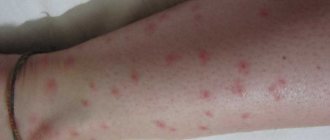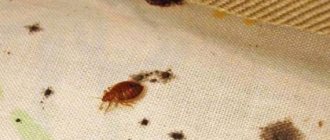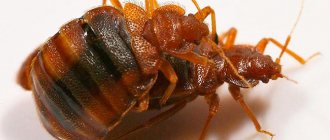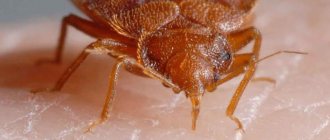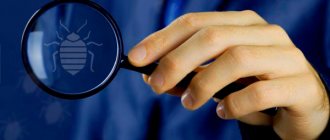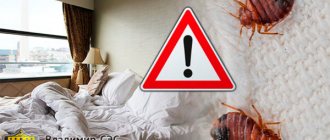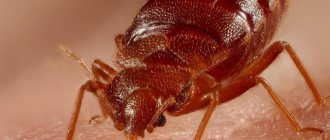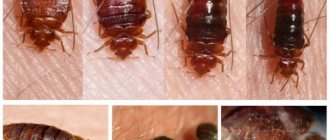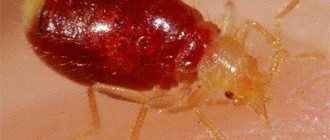Description, characteristics and structure of bedbugs
The bug is a hemiptera insect, the name of which is associated with the special structure of the front wings, transformed into elytra. Most of them are a hard chitinous shell.
These insects have 3 pairs of equally developed limbs, with the help of which they move on land, in water and hold prey. Most bedbugs have open ducts of scent glands between the 2nd and 3rd pairs of legs, which emit a characteristic odor. Predators and those that live in water have no scent glands or they are poorly developed.
Well-developed sensory antennae are organs of touch. Some species of these insects have excellent vision.
What they look like
The body shape of most bugs is adapted to the living conditions, so it can be different. Bed bugs differ:
The bug is a harmful turtle.
- flat - parasitic creatures that become round after saturation;
- spherical - these are representatives of the family of earthen shields and desert ones;
- rod-shaped - a separate species, which includes Ghilianella filiventris;
- harmful turtles.
Some species are less than 1 mm long, and the largest reach 15 cm. Females are always larger than males.
The color of these insects can be of 2 types: repellent and display. All parasites, as well as those species with poorly developed odorous glands, have protective colors. Bright colors, which combine red, blue, green and black, are herbivorous species that have no enemies in nature.
Types of bedbugs
Bedbugs are divided into the following types:
- useful;
- harmful;
- harmless.
The soldier bug belongs to the last category. The insect wakes up in early spring. The peculiarities of these bugs lie in their numbers and bright colors. They feed on the sap of young vegetation, seeds and dead insects.
Another harmless bug is the alder bug. It lives on the leaves of birch or alder.
Beneficial bugs
Small ground bugs feed on eggs, larvae and small insects. These nutritional features are used in biological plant protection in greenhouses.
The bug Macrolophus nubilus is used against spider mites, aphids and whiteflies. This type is specially populated in greenhouses. During the breeding season of pests, bedbugs first eat insects of a given species, and then destroy others.
To control pests indoors, bugs from the genus Orius are used. The size of these small insects is only 2 mm. Orius breed equally well in wet and dry places. These bugs destroy thrips and spider mites, whiteflies and aphids.
Parasitic bugs
There are 2 types of bedbugs that parasitize people and animals, these include:
Types of bedbugs parasites.
- bed bug;
- kissing bug.
There are up to 100 types of bedding. The insect does not have wings, but has a good sense of smell, which helps to find blood vessels. If the pest has a choice between an adult and a child, it will bite the latter.
The kisser carries a mortal threat because it suffers from Chagas disease, which can only be cured at the initial stage.
The following species harm plants:
- the cabbage bug is an enemy of cruciferous plantings, sucking juice from the leaves;
- rapeseed - destroys radishes and radishes;
- light green shield bug - prefers berry juice and plant leaves, can feed on carrion;
- lined scale insect - loves the juice of parsley, dill and carrots;
- harmful bug - spoils wheat, barley, oats and corn;
- berry - lives on currant, raspberry, and gooseberry bushes.
The majority of bedbugs are herbivorous; pests include those that destroy agricultural crops.
Lifespan and habitat
Despite its name, bed bugs do not live in beds. Insects choose dark places in the vicinity of the victim, where no one will disturb them. They are nocturnal, making them difficult to detect. During the day, these parasites sleep, pressing both their backs and bellies to the surface of the furniture.
Bedbugs most often form nests in the following places:
- in parts of the mattress that are adjacent to the bed frame;
- in the folds of furniture upholstery;
- between the headboard and the wall;
- behind loose wallpaper, wall hangings;
- between the battery and the wall;
- in bedside tables;
- in cabinets, incl. book;
- in floor cracks or baseboards.
The more parasites there are in a room, the wider their habitat. If there is a heavy population, pests can live in adjacent rooms. These insects move quickly, so they can get to the feeding site without any problems.
The life of a domestic insect is directly related to humans and the conditions available in the room - warmth and low air humidity. Temperatures affect the lifespan of the parasite without food. If the room is cool, the insect can survive up to 1 year. At high temperatures, metabolic processes accelerate, which shortens the life of the parasite. At average temperatures, bedbugs can live 14-15 months.
What you need to know about bedbugs
The most common question is: how to detect bedbugs in or in bed. It directly and unequivocally confirms all of the above. Let’s just imagine a situation in which a person could have such a problem: he is bitten by insects at night, in the morning he wakes up covered in bites, suspects that they are bedbugs, starts looking for them, and does not find them. Why? That's right, because there aren't any in the bed. And therefore you need to look for them not in the bed, but in other places in the room.
Another question may be related to this: who, besides bedbugs, can bite in bed. The situation is the same - a person is bitten, but he does not find bedbugs. And he begins to wonder who it is. It gets to the point where he thinks he was bitten by cockroaches. We have already said before that this is practically impossible and cockroaches do not bite people. Although in reality other insects can bite a person in bed. But first things first.
First: where do bed bugs come from? They come on their own. They are either taken into the premises from neighbors, or people accidentally bring them in with bags, furniture or household appliances. Animals cannot tolerate bedbugs. Only people - either the residents themselves or their guests. All. There are no other reasons for the appearance of bedbugs in the apartment.
Indoors, they hide in a variety of places - wherever they are not visible, where they are not disturbed by people and pets, where they are difficult to reach, and from where they can quickly run to a sleeping person at night. They can be everywhere in the bedroom, and even outside it.
And, by the way, immediately after an apartment is infested, people practically do not feel bedbugs. Usually 1-2 bedbugs get into an apartment, rarely more. And it takes several months until they have offspring and there are so many of them that the bites will be regular and multiple. That is, usually if bedbugs appear in your bed, it means that they entered the apartment no less than a few weeks or months ago. The only exception is insect baiting from your neighbors, when bedbugs can move to you in hordes and bite you a lot at once.
It is from here, from different places in the house, that they come to bed at night. It takes a bedbug less than a minute to run from the opposite corner of the room to the bed, that is, they do not have an urgent need to settle in the mattress. However, if there are secluded safe places here, in the bed or on the sofa, the bedbugs remain here for the day.
By the way, we already talked about sofas. This is a separate big song. Sofas have a huge number of places where bedbugs can hide, and therefore they are found in them much more often than in beds. Moreover, the older the sofa and the more opportunities bedbugs have to get under the upholstery into the filling, the more likely it is that they will be there and the sofa will need to be thrown away.
Beds are better in this regard because they have fewer places for bedbugs to hide. Consequently, beds almost never have to be thrown away.
However, you also need to look for bedbugs in the bed itself before poisoning them. To do this, the bed needs to be disassembled. The mattress is removed and carefully inspected - there may be bedbugs on its seams, in the places where it touches the frame and sides. Here you can also find dry chitinous coverings shed by insects during molting, the bugs themselves of different ages - both adult brown and young nymphs, white and translucent - all this must be carefully examined.
If the mattress is intact, then there are no bedbugs inside it. If it is full of holes, then perhaps there are parasites inside it and it is easier to throw it out than to remove insects from it.
Next, you need to inspect the sheathing itself and the entire frame, all the cracks and joints of wooden structures. It doesn’t matter whether you find bedbugs or traces of their activity here or not, this entire frame needs to be disassembled: remove the sheathing, unscrew the frame, put all the parts separately from each other.
The fact is that bedbugs, due to their flattened bodies, can even climb into the cracks in the joints between boards, and until you unscrew these boards from each other, you will not see these parasites. And when all these elements lie separately, you will be able to see how many bedbugs there are in the bed.
By the way, bedbugs also live in iron beds. Both in cribs and folding beds. Moreover, where the metal tubes are not closed with plugs, they get inside and cannot be seen there. But, in fact, this is the easiest way to kill them - just close the tube with a stopper and that’s it, the bugs won’t be able to get out of there.
In practice, cases are different. There are situations when a bed or sofa is completely disassembled, and there are no bedbugs visible at all. Or you get 1-2 parasites. And it happens that the mattress is removed, and underneath it there are crowds of bedbugs running all over the boards. But almost always, if bedbugs are found in a bed, they can also be found in other places in the room.
Here we also need to say how to find out that there are bedbugs in the bed.
How do they reproduce?
Bed bugs belong to the group of insects with incomplete metamorphosis. They do not have a pupal stage; larvae (or nymphs) develop into adults as a result of several molts. Thus, the full cycle includes 3 stages:
- egg;
- nymph;
- sexually mature individual.
The fertilization process is traumatic. In order for the seminal fluid to enter the female, the male cuts through her abdomen with his genital organ. Sperm penetrate the body cavity, some reaching the ovaries.
A male can copulate up to 200 times per day. The insect is not able to determine which sex an individual belongs to, so it mates with everyone. Males can attack each other. Someone else's sperm, which gets inside, does not die, but mixes with its own. Now, during copulation, such a male throws not only his sperm into the female.
After the first fertilization, the female can lay eggs for the rest of her life. Once inside, sperm are stored in the body and used when needed. The reproduction process does not stop; with normal nutrition, the female can lay up to 10 pieces. in a day. Hatching occurs on the 4th day or after 3 weeks. Insects quickly emerge at a temperature of 35°C and high humidity.
The masonry is well protected, so it is not always possible to destroy it with the help of poisons. If eggs are found, the nest should be treated when the larvae hatch.
Nymphs develop quickly only with good nutrition. If there is not enough food, then development slows down, but as soon as the insect receives a new portion of blood, the growth process resumes.
The best place for breeding is city apartments, where the temperature is high, there is always food and there are many hidden and safe places to live.
How do bedbugs bite?
The bedbug's mouth is of a piercing-sucking type, looks like a segmented proboscis on the head and is adapted for sucking liquids. There are 2 channels in the bug's proboscis: one is designed to suck in blood, the second is for introducing an anesthetic into the bite.
How a bed bug bites.
The length of the proboscis is only 0.7 mm, so the parasite searches for an area of skin where blood vessels are located close to each other. For 1 bite, the insect absorbs about 1-1.5 μl of blood. After receiving the dose, the bug crawls 2-4 cm to bite again. In a young individual, the bite takes 2-3 minutes, in an adult – 15 minutes.
The bug leaves 3-5 bites on the body and during this time takes up to 7 µl of blood. This portion is enough for an insect for a week. However, it all depends on the number of parasites in the room. If the area is densely populated by these parasites, then in the morning there may be up to 500 bites on the body.
Consequences of bites
The bite has the following symptoms:
- swelling around the bite;
- severe itching;
- inflammation;
- red spots located close to each other.
A dangerous consequence of this insect bite is an allergy. There were even cases when the victim experienced anaphylactic shock. In addition, allergic reactions can cause the following consequences:
- erosion of the skin;
- severe swelling in the bite area;
- spasms in the bronchi;
- hyperemia;
- urge to feel sick;
- fainting.
In most cases, a bedbug bite is no more dangerous than a mosquito bite. These insects do not carry infections that are dangerous to humans.
Sometimes a skin rash appears. At the same time, bugs crawling on the bed can cause psychological disorders. A person is afraid to sleep, which causes his health to deteriorate, his performance to decrease, and his nervousness to increase.
In some cases, bites do not heal for a long time and begin to fester. This may be a sign that the wound has become infected when scratched.
How to treat
There is no universal remedy for bedbug bites, because the reaction of each person is unpredictable. In the best case, redness and swelling disappear within 10 hours. If an allergy occurs, it takes several days to heal. Most often, a blister appears at the site of the bite, which bursts and disappears.
Used for allergies after bed bug bites.
To eliminate unpleasant symptoms, ice and anti-itch ointment are used. Appropriate medications are taken for allergies. You can use Fenistil gel or Rescuer. Before applying the ointment, you need to disinfect the bite site.
What to do with bedbugs found in bed
What to do if you find bedbugs in the bed and in other places in the room? They need to be destroyed. To do this, these places need to be treated with products that quickly kill bedbugs. These can be, firstly, insecticidal preparations based on organophosphorus compounds or neonicotinoids, or with a complex composition, which may also include pyrethroids.
On a note
It is better not to poison bedbugs with pyrethroids - they often develop resistance to these substances.
To treat the room yourself and prepare a working solution at home, you can take Get, Executioner, Lambda-Zone, Hector, Xulat, Tetrix - they are quite effective and resistance to them is extremely rare. They need to treat all the places where bedbugs are found, the entire bed and the entire mattress, all baseboards and those surfaces on which bedbugs move when they crawl from hiding places to your bed. Accordingly, you need to choose the appropriate amount - not only for the bed, but for the entire room.
The same Executioner, for example, according to customer reviews in online stores, you need to buy at least 5 bottles per room. If you take less, then there is often a need for re-processing.
Just when you buy a product, ask the seller how much you need to take for a specific area, taking into account the number of beds. The beds themselves with mattresses usually spend the same amount as the rest of the area.
Another way to deal with bedbugs is to warm the room to 50-55 degrees using a powerful fan heater, and maintain this temperature for 1-2 hours. Moreover, you need to remove the mattresses from the beds and place them against the wall. Furniture needs to be moved away from the walls. In this case, all the places where bedbugs hide will warm up to this temperature and the insects will die. We conducted an experiment and verified that at +50 degrees, bedbugs die in 10 minutes. That is, in an hour at this temperature in the room, all parasites will die.
Theoretically, it is possible to destroy bedbugs using a steam generator, but in practice it is not possible to get rid of them using a steam generator alone. Typically, a steam generator is used in addition to the application of insecticides. The steam is passed over the mattress, along the baseboards, and other places are treated with chemicals.
And it is important to treat the disassembled bed in this way so that the product reaches all the places where bedbugs can hide.
There is no need to treat the bed with anything. It is enough to wash it at the highest possible temperature so that those bugs that accidentally end up on it die.
Symptoms of infection
The most obvious evidence that there are bed bugs in the house is the discovery of an adult bed bug. At the same time, sometimes a living insect may indicate that the neighbors are being disinfested, and the surviving bloodsuckers have found a new home. Thus, when an adult is identified, the potential habitats of these parasites should be immediately inspected.
Bites on the body
The main symptom of bedbug infestation is bites that regularly appear on the skin. Red marks appear on the neck, back, cheeks and arms. Parasites do not bite in hairy areas; they choose places where the skin is thin and smooth. For this reason, children and women suffer more from these insects.
Bed bugs become active at night, so new bites can be detected in the morning immediately after waking up. Small red bumps are sometimes confused with an allergic reaction.
In this case, the bedbug bites are close to each other, forming a path. The number of red bumps on the skin increases every day along with the insect population, which is rapidly increasing. If the fight against parasites is not carried out, then a person can be bitten up to 300-350 times during the night.
Traces of blood on the bed
The substance that the parasite injects under the victim’s skin disrupts blood clotting. For this reason, a drop of blood appears at the site of the lesion, which, falling on the bed, leaves a mark. Bedding and waste products contaminate.
To remove stains, rinse the fabric in cold water. You can also remove traces with hydrogen peroxide (3-5%).
Hydrogen peroxide removes traces of blood stains after a bug bite.
The appearance of blackheads
Bedbugs are living creatures, so they have a digestive process and waste. Parasite feces are liquid and dark brown in color, but they quickly cool and become hard.
You can find excrement anywhere in your home. Most often, parasites accumulate near or on the bed. The smell of bedbug waste resembles bad cognac.
When the larva hatches from the egg, it molts several times as it grows. Each time it sheds its chitinous coating, which can be found on the floor, furniture, and windowsill.
Unpleasant smell
The sense of smell is a way for bedbugs to navigate in space, mate and notify their relatives of danger.
The aroma that these parasites exude is pleasant - sickly sweet, reminiscent of the smell of almonds or rotten raspberries. If there are a lot of insects in the apartment, the aroma becomes constant. If you smell this smell at least once in your life, you will no longer be able to confuse it with any other.
Why do bedbugs migrate to new apartments?
Let’s imagine a situation where in a multi-storey building, bedbugs first infested only one apartment. The owners most likely brought them there by accident. Gradually, the bugs multiplied there and infected the entire room. Accordingly, they have enough food there, since otherwise they would simply die out. They also have places to create nests. If the shelters were unreliable, the residents would have discovered the parasites long ago and destroyed them. Consequently, bedbugs, in principle, have no incentive to try to penetrate neighboring apartments. Their movement is fraught with danger. They can catch the eye of people and be destroyed, or end up in rooms where there is no food, and it is extremely difficult to get out of them. For example, parasites can get into a garbage chute or elevator shaft. In general, for them to decide to leave their shelter and go in search of a new one, they must have a serious reason. Let's consider what they can be.
The first reason is considered to be overpopulation. When the number of bedbugs increases greatly, some individuals begin to look for new places to create nests and new sources of food. For example, you can see what a very severe infection of an apartment can be like using the example of a home that we treated in Balashikha:
Similar mechanisms have been studied in detail in bees and ants, which have a strict social hierarchy. It is also known how mice and rats disperse. When too many individuals gather, some begin to develop psychological stress, forcing them to look for more secluded places. Also, as the rodent population increases, competition for food increases, causing some of them to look for it in new places.
It is difficult to say why bedbugs spread, since it makes no sense to consider the psychological factor, and they also have no competition for food. It is unlikely that there would be so many bedbugs that there would physically not be enough space on a person’s body to bite him. However, when they reach a certain number, they still begin to move into neighboring rooms.
Thus, if one of the neighbors has bedbugs, then most likely they will appear in other apartments. Residents of the first may not be aware of the proliferation of parasites because some people do not feel their bites, or they may not take measures to remove them, or their methods may be ineffective.
The second reason may be carrying out disinfestation in an infected apartment. For example, if there were no bedbugs, but suddenly they started running everywhere, it means that one of the neighbors is poisoning them.
The third reason may be the departure of people from the contaminated premises. Without a regular source of food, the parasites will begin to escape from there in search of new habitats.
It is important to consider that bedbugs will enter the apartment from neighbors only if they physically have the opportunity to do so. Since their bodies are very small and flattened, they usually have such an opportunity.
This photo shows what an adult bedbug looks like:
It can be seen that, due to its almost flat body, it can quickly crawl through cracks between pipes and concrete, pass through grooves with wiring, and climb through gaps between windows and mosquito nets. At the same time, if the apartment has been well renovated, all the cracks are insulated with sealant or putty, the doors and windows are sealed with special rubber bands, and there are plugs in the sockets, then bedbugs will not have the opportunity to get inside such a home.
In general, there are no other causes of bedbugs. They either enter the apartment themselves in search of food, a place to create nests, or to escape danger, or they are accidentally brought there by people.
Methods for detecting bedbugs in an apartment or house
To detect a bedbug, you need to know the places where it can hide. The search begins with an inspection of sofas and armchairs, bed linen, and mattresses. You should check the linen closet, bedside tables, and electrical appliances. These parasites also live under carpets, baseboards, linoleum, parquet floors, flower pots, and between books.
To confirm the presence of bedbugs, you can do the following manipulation: make a solution from a bucket of water, a few drops of alcohol, a decoction of wormwood, tansy or 9% table vinegar. Moisten the floors and baseboards with the resulting mixture. After this, the insects will immediately begin to leave their homes.
Where do bedbugs hide and how to deal with them?
The first step in how to deal with bedbugs yourself is to conduct a quality inspection of the room. Check out the favorite places of bloodsuckers in the apartment, which are given in the following list:
- Inside the bed (in joints, cracks, fastenings) and on the back of the headboard.
- Along the seams of the mattress (remember to raise the edge) under the bedding and on the pillows under the pillowcases.
- In cracks and crevices of walls and ceilings, including baseboards, sockets and switches.
- On the back of a wall hanging hanging by the bed (primarily along the perimeter along the seam).
- In and around sofas and easy chairs, starting from the back surface of the backrest (for a good inspection, you may have to disassemble the furniture, but believe me, this is not in vain).
- Behind the frames of photographs and paintings, under wall clocks and lamps.
- In linen closets, chests of drawers and bedside tables, both inside and outside on the back wall.
- On curtains and curtains, especially in the upper part. Note that black bedbug fecal stains on curtain and tulle fabrics spread and take the form of blurry crosses, which are sometimes superstitiously mistaken for supernatural occult signs.
It is useful to know that the infestation of a room with bed bugs begins with the sleeping place. As the insects reproduce, they gradually develop new secluded places near the bed, and then move further and further. Therefore, the inspection should begin from the bed, taking into account the instinctive preferences of bedbugs. 95% of parasites’ favorite places in an apartment are concentrated within a radius of two meters from the bed or sofa.
So, if bedbugs have nevertheless entered the house, how to deal with them, read on.
How to get rid
To decide on the method of destruction, you need to understand how many parasites live in the apartment. To get rid of bedbugs yourself, you can use insecticides, among which are the following:
- liquid Karbofos;
- liquid Executioner;
- spray Klopomor;
- pencil Mashenka;
- Get microcapsule product.
You can fight bedbugs in the following ways:
- Freezing or heat treatment. At the same time, the heating system may suffer from the cold, and renting a heat gun is expensive.
- Collection with a vacuum cleaner or by hand. This method is labor-intensive and not very effective.
The most reliable way to get rid of parasites is to call an exterminator. Specialists come with special equipment and products that are toxic to insects but safe for humans. Since these bloodsucking creatures quickly migrate from one apartment to another, it is advisable to simultaneously treat the entire entrance.
In order for pest control to bring maximum results, you should move the furniture away from the walls and free the edges of the carpets before the specialist arrives. All food, dishes and personal hygiene items must be removed from the house. After treatment, the apartment is wet cleaned and ventilated.
How to deal with bed bugs in an apartment - quick facts
First, we list the key points regarding the fight against bedbugs, which will be discussed in detail in the article:
- In Russia, as in other countries of the world, the spread of bed bugs is progressing.
- The fight against bed bugs is complicated by two factors: the insects' ability to resist chemical pesticides and their natural ability to hide unnoticed in narrow, cramped spaces.
- Homeowners can protect themselves from bedbug bites by enclosing mattresses and box springs in impermeable material and using retention traps at the base of the bed legs.
- Putting things in order and getting rid of trash, as well as wet cleaning and thorough cleaning of surfaces with a vacuum cleaner, help reduce the number of bed bugs and their eggs in the apartment.
- No preventive method works as effectively as early diagnosis of the infestation, immediate extermination of bedbugs and practical measures to prevent re-infestation.
- Due to the increased resistance of bed bugs to pesticides and the specific nature of their lifestyle, not all insecticides work against these parasites. Products in the form of household insect repellent aerosols rarely cope with bloodsuckers. Insecticides used by professional services destroy bedbugs incomparably more reliably, but even these products do not guarantee a 100% result in every case.
- Heat treatment and freezing are effective physical methods of controlling bedbugs. For example, bed linen is cleaned of bloodsuckers by washing and hot machine drying.
